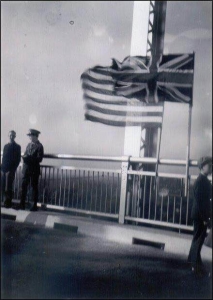by Scott Stephenson for the Sarnia Observer
(2003) A silver arch of steel standing out like a rainbow in the sky above the St. Clair River. That’s as fitting a description today as it was on Oct. 8, 1938 when the original Blue Water Bridge was officially opened to the public. Extending from Port Huron to Point Edward the bridge was dedicated as “a new bond of friendship and commerce between the two English-speaking nations of this continent,” by Ontario Premier Mitchell E. Hepburn and Michigan Gov. Frank Murphy.
Thousands on both sides of the river witnessed the afternoon ceremony while millions more around the world heard the proceedings over an enormous radio network. “We have gathered to dedicate a great new instrument of commerce between two neighbours in the family of nations,” Gov. Murphy said. Hepburn called the bridge “another avenue of transportation connecting the United States of America and the Dominion of Canada.”
Prior to the dedication ceremony on the Port Huron plaza, Gov. Murphy came to the Canadian side and exchanged pleasantries with Premier Hepburn. While the meeting was impressive, there was a point in the program on the Canadian plaza shortly before Murphy’s arrival that combined impressive colour and inspired patriotic fervor in those who witnessed it. That occurred when a bodyguard of 70 veterans of the Great War snapped to attention for inspection by Premier Hepburn. Dressed in blue blazers and berets and white flannels, their chests adorned with medals won on the field of honour, the appearance of the youth of nearly a century earlier caused a tug at the heart strings.
During the ceremony in Port Huron, speakers recalled for the benefit of their audience the years of patience which the people of this international district went through before the building of the bridge was authorized. The people of Michigan and Ontario who heard their words considered the mental picture of the new bridge which, it was suggested, resembled the shape of a rainbow. The silvery semblance of the bridge was bestowed upon it as the final touch.
Many of the members of the state, federal and provincial governments of the two countries that furnished the funds to build the approaches to a centre span financed by bonds, were among those who witnessed the opening of the bridge. The assembling of the people of Canada and the United States in the historic ceremonies was reflected in an equally patriotic manner by the joining of the two flags in a symbolic opening of the span to vehicle and pedestrian traffic.
The Stars and Stripes and the Union Jack were entwined across the approaches at either side of the bridge, and as the premier and the governor announced the entrances in their countries formally opened, the flags were raised. Boy Scouts in Point Edward, almost a mile from the speakers’ platform, heard the voice of their premier over a public address system, and raised the flags, turning what had been a barrier into an arch. The ceremony was repeated on the American side.
Bands played and aerial bombs were fired as other flags of the two nations were unfurled in the centre of the bridge. Airplanes from the United States naval base, south of Detroit, zoomed overhead, while crowds cheered and whistles blew in recognition of this day of days.



